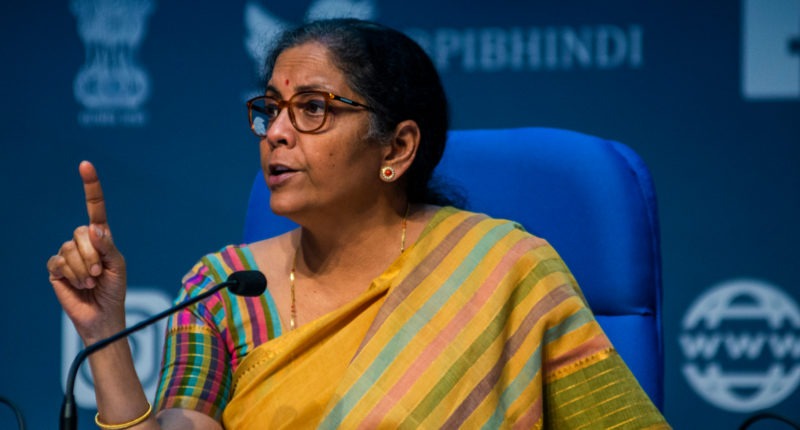The Finance Minister (FM) Smt. Nirmala Sitharaman announced, in a press conference, a new stimulus package to boost the Indian economy as it recovers from the COVID-19 pandemic. This package is the third part of the Aatmarnirbhar Bharat campaign. The FM stated that the Indian economy had seen a strong recovery with the active COVID-19 cases now at 4.89 lakh, having reduced from 10 lakh, with a fatality rate of 1.47%.
From an economic standpoint, there has been great progress made in GST collections, with the collections crossing the 1 lakh crore mark for the first time in eight months this October 2020, and standing at Rs.1.05 lakh crore. It also saw a 10% increase year-on-year. The RBI has predicted that there is a strong likelihood that the Indian economy will return to positive growth in the third quarter of 2020-21, which is a quarter ahead of the earliest forecast.
A new scheme called ‘Atmanirbhar Bharat Rozgar Yojana’ has been launched to incentivise the creation of new employment opportunities. Under this scheme, new employees joining an Employees’ Provident Fund Organisation (EPFO) registered establishment with monthly wages less than Rs.15,000, will be eligible for benefits. They should have exited employment between 1st March 2020 and 30th September 2020, and are employed on or after 1st October 2020.
Establishments under the ‘Atmanirbhar Bharat Rozgar Yojana’ scheme will get subsidies for all new employees joining, provided a minimum of two and five new employees are added if the reference base is up to 50 and over 50 employees respectively as of September 2020.
The scheme is to be operational until 30th June 2021. The subsidy will include 12% of wages towards the employer’s and employee’s Provident Fund (PF) contributions for employees in establishments employing up to 1,000 candidates. For establishments with employees over 1000 employees, it will only include the employee’s EPF contributions of 12% of wages. The subsidy support will get credited upfront in the Aadhaar-seeded EPFO account of eligible new employees.
An Emergency Credit Line Guarantee Scheme had been announced as part of Aatmarnirbhar Bharat Abhiyan and has now been extended until 31st March 2021. It involves credit being provided to MSME units, business enterprises and MUDRA borrowers, as well as individual loans for business purposes.
An additional credit of up to 20% of outstanding loans as on 29th February 2020 for entities with an outstanding credit up to Rs.50 crore and an annual turnover up to Rs.250 crore. The outstanding loans should be no more than 60 days past the due date as on 29th February 2020. As of 12th November 2020, Rs.2.05 lakh crore has already been sanctioned to 61 lakh borrowers under this scheme, of which Rs.1.52 lakh crore has been disbursed.
A new guaranteed credit scheme has been launched to support 26 stressed sectors which have been identified by the Kamath committee, plus the health care sector, with credit outstanding of Rs.50 crore and up to Rs.500 crore as on 29th February 2020. The credit guarantee is to be utilized for 100% guaranteed collateral-free additional credit at capped interest rates. The scheme will be available until 31st March 2021.
Also Read: EPFO Makes Provision to EPS Pensioners to Submit Digital Life Certificate
A production-linked incentive scheme of Rs.1.46 lakh crore has been launched to boost manufacturing for 10 Champion sectors. An additional outlay of Rs.18,000 crore has been released for PM Awaas Yojana (PMAY) – Urban, which is expected to create 78 lakh additional jobs and increase consumption to 25 lakh metric tonnes (LMT) of steel and 131 LMT of cement.
Relaxation has been granted on the Earnest Money Deposit (EMD) and Performance Securities on government tenders. The Earnest Money Deposit (EMD) will not be required for tenders and will be replaced by a bid security declaration. The Performance Security on contracts will be reduced to 3% instead of 5% to 10%. These relaxations will be valid until 31st December 2021.
The economic slowdown has led to a decline in the prices of residential units. Hence, a demand booster is being provided for residential real estate in the form of an Income Tax relief for developers and home buyers. Section 43CA of the Income Tax Act restricts the differential rate between the circle rate and the agreement value to 10%.
This differential rate has been increased to 20% for the period from the date of this announcement until 30th June 2021 for only the primary sale of residential units of value up to Rs.2 crore. A consequential relief up to 20% shall also be allowed to home buyers under section 56(2)(x) of the Income Tax Act for the said period. This measure will reduce the hardships faced by both home buyers and developers, as well as help clear the unsold inventory.
The government has launched a Rs.1.10 lakh crore platform for infrastructure debt financing. The government is making an equity infusion to the extent of Rs.6,000 crore in the National Investment and Infrastructure Fund (NIIF) debt platform. The NIIF has already raised equity worth Rs.8,000 crore. The rest will be raised from private investors. By 2025, the NIIF will be geared towards providing project financing worth Rs.1.10 lakh crore.
On the agriculture front, an amount of Rs.65,000 crore is allocated for subsidised fertilisers, which will help 140 million farmers. It will ensure the adequate availability of fertilisers for the upcoming crop season. An additional outlay of Rs.10,000 crore will also be provided for the PM Garib Kalyan Rozgar Yojana in the current financial year to accelerate the growth of the rural economy.
For promoting project exports, an amount of Rs.3,000 crore is going to be released to EXIM bank through Lines of Credit (LOC) under the IDEAS scheme. An additional amount of Rs.10,200 will also be provided towards capital and industrial expenditure. This move is expected to benefit sectors such as domestic defence equipment, industrial incentives, industrial infrastructure and green energy.
Lastly, it was announced that the COVID Suraksha Mission would be granted Rs.900 crore for the research and development of a COVID vaccine. However, this amount will not go towards the distribution of the COVID vaccine. All the stimulus measures that have been announced till date amounts to Rs.29.87 lakh crore, and this is 15% of the overall GDP. The government’s share alone of the stimulus measures is 9% of the GDP.
For any clarifications/feedback on the topic, please contact the writer at athena.rebello@cleartax.in

I’m a Chartered Accountant by profession and a writer by passion. ClearTax lets me be both. I love travel, hot tubs, and coffee. I believe that life is short, so I always eat dessert first. Wait.. life is also too short to be reading bios… Go read my articles!





